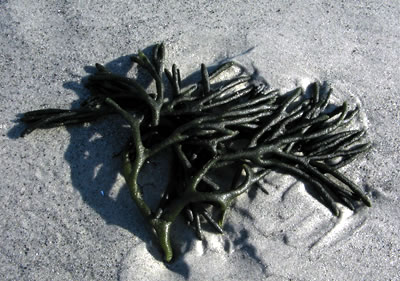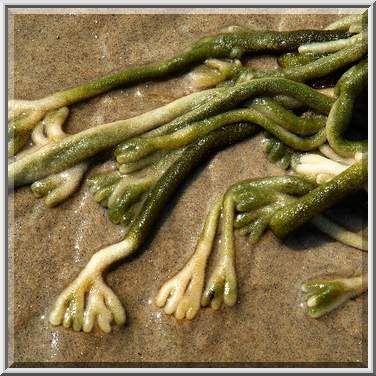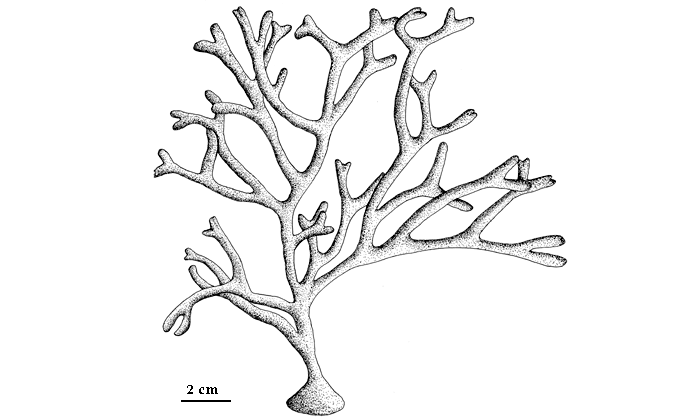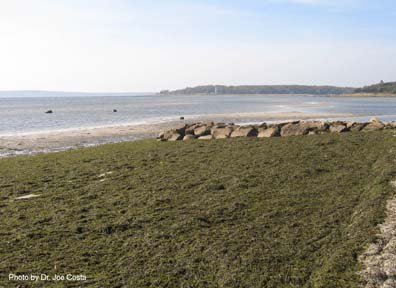Scientific
Name: Codium fragile
Codium fragile washed ashore in Goucester, Massachusetts.
Classification:
Class: Chlorophyceae or Bryopsidophyceae
Order: Codiales or Bryopsidales
Family: Codiaceae
Genus: Codium
Species: Codium fragile
Original Distribution:
 Current Distribution:
Current Distribution:
Codium fragile has made its way
around the world, growing along the coasts of Southwest Africa,
Australia,
southern Argentina, Chile, China, Denmark, England (particularly the
British
Isles), Ireland, Korea, Atlantic and Pacific coasts of North America,
Norway,
Netherlands, New Zealand, Scotland, and
Sweden.
Site
and Date of Introduction:
Traveled from the Asian Pacific, particularly Japan, to
mainland Europe. From there, it was introduced to England, to the River
Yealm in Devon,
in 1939, and first discovered at Steer Point. The first recorded
sighting in the U.S. occurred in 1957 on Long Island, New York,
followed by Boothbay Harbor, Maine in the early 1960’s. Since then, Codium has spread up and down the
east coast of the U.S., heading north to the Gulf of Saint Lawrence,
and
south to the Carolinas. A full-scale invasion is occurring in
Massachusetts, where codium is washing up in such large quantities in
some Cape Cod communities that beaches must be closed to the public.
Mode(s)
of Introduction:
Its main method of transportation from port to port is
believed to be on the hulls of ships, or attached to captured
shellfish. Human activities including boating and shellfish collection
also contribute to dispersion.
Reason(s) Why it has Become Established:

Codium fragile
has become
well established in a wide variety of climates in its
current distribution.
This success is due to the seaweed's versatile requirements for
sunlight,
nutrients, and reproductive conditions. Codium grows best in
low sunlight,
which helps it to thrive in light obstructed areas, including developed
coastal
regions featuring human-wrought structures, beneath and upon which it
may
attach and thrive in the shade. Thanks to advanced storage
capabilities, Codium fragile can rely on reserves of nitrogen
during seasons
or in areas of limited resources. Thus far, Codium has
resisted conservation
efforts to reduce its prolifity via reproductive versatility: Dead
Man's
Fingers can reproduce sexually, when a female gamete is fertilized by a
male gamete; parthenogentically—when the female gamete develops into a
new
individual without fertilization; or vegetatively--when a
genetically
identical individual is formed from a branch or stem of the parent
plant.
Ecological
Role:
Codium fragile grows along intertidal bands close to
shore, or along the shore in caverns and tidepools. It prefers areas
that are unlikely to freeze, and grows well in sheltered areas
including harbors and bays. It
is a source of food for many invertebrate species, though not usually a
primary
food source. Codium provides an important service for the Alesia
sea slug, which takes chloroplasts from its siphonous branches, and
stores
them in a gland where the choroplasts help to produce the slime used by
the slug in locomotion. In new habitats, codium
displaces
native sea grasses and seaweeds, disrupting life for the multitude of
fish
and invertebrate species they contain.
Benefit(s):
Codium fragile is consumed by humans in some areas of
its distribution, and is used as feed for various species of
invertebrates in the mariculture industry.
 Threat(s):
Threat(s):On the surface, Codium becomes an aesthetic nuisance along the shore where it wraps around rope and dock pilings, and washes up to rot on beaches, emiting a pervasive stench. Beneath the surface, however, it is a well-armed invader. Inherently damaging to shellfish, Codium adheres to shells to serve as a home base. By wrapping its roots and branches around shells, it impedes the locomotion and feeding of shellfish such as oysters, mussels, and scallops, and may dislodge them from the seafloor. In addition, Codium tends to overgrow and smother oyster beds, earning it the fisherman's label, the "oyster thief". This species is also likely to displace native seagrasses and seaweeds, such as eelgrass, or kelp species. Because of its bush-like growth pattern, Codium is considered a "low-lying alga". Dense bushels prevent larger species of fish and mammals from swimming freely through intertidal areas. North Atlantic coasts are particularly affected by this aspect, where native kelp forests traditionally allowed for easy movement, food, and shelter, and nurseries to a diversity of fish species. Many species of sea urchin also depend on kelp for food and shelter. Codium obscures these relationships, reducing sea urchin populations. In areas of complete overgrowth, Codium has annihilated the kelp beds of the North Atlantic, off the coast of Nova Scotia and Maine. Because Codium bushes do not offer the same resources as Kelp forests, in areas where it is replacing Kelp, traditional communities give way to a Codium-dominated ecosystem.
Control
Method: Due to ecological durability and rapid and versatile
reproductive rate, chemical and mechanical removal options have been
ruled out. Studies are in progess to determine natural parasites.
Sources:
Massachusetts Office of Coastal Zone Management, Massachusetts
Aquatic Introduced Species Management Plan
http://www.mass.gov/czm/czmail/2003/oct2003.htm
The
Marine Aliens program
http://www.marlin.ac.uk/marine_aliens/marine_aliens.htm
Global
Invasive Species Database
http://www.issg.org/database/species/ecology.asp?fr=1&si=796&st
Marine
Pests Information sheet
http://www.marine.csiro.au/crimp/Reports/Infosht14_Codium0201S3.pdf
Northeastern
University
http://www.biology.neu.edu/faculty03/cheney03.html